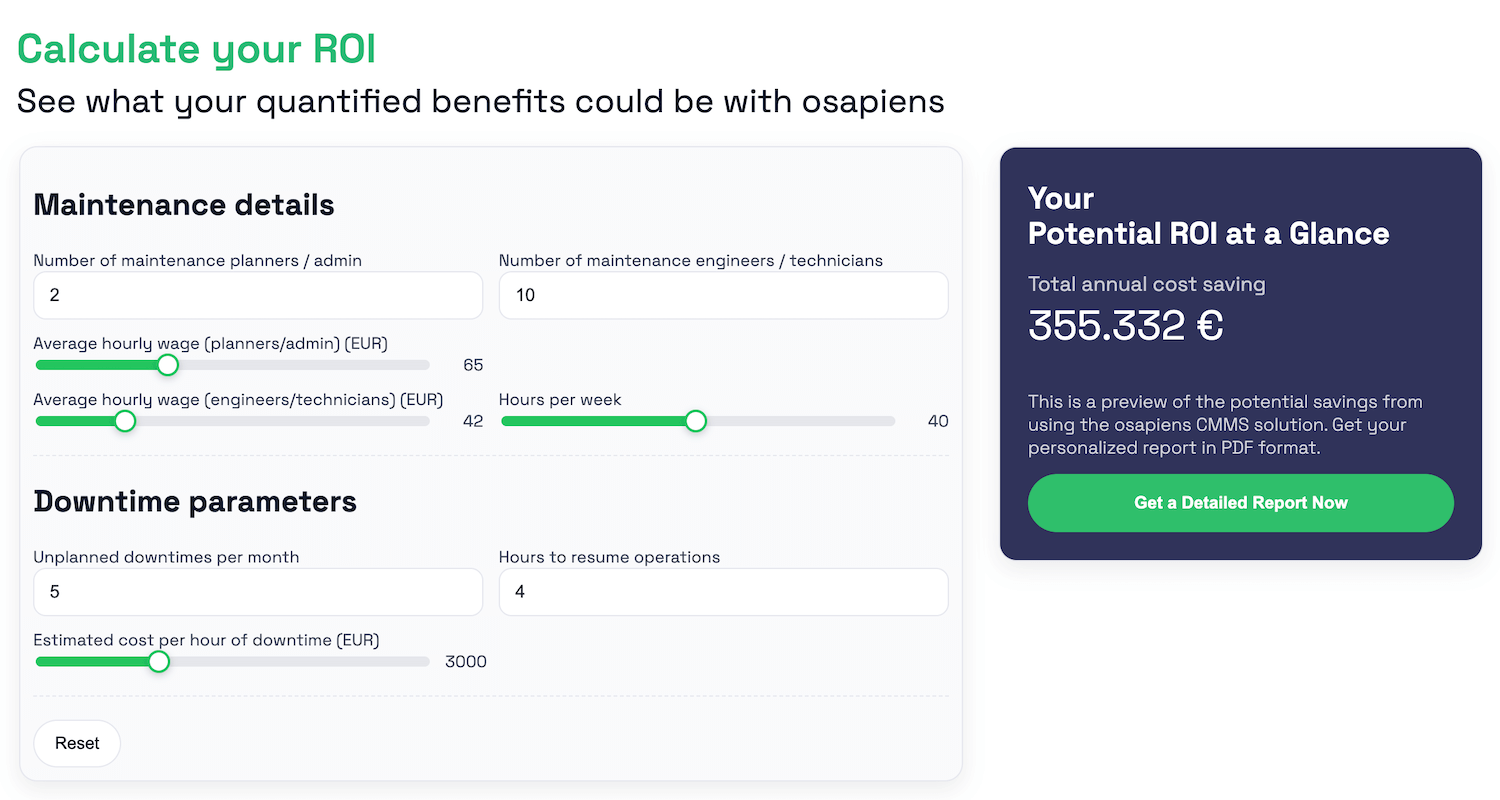 Florian Bartholomäus,
osapiens Expert | 29. October 2025 | Lesezeit 10 min.
Florian Bartholomäus,
osapiens Expert | 29. October 2025 | Lesezeit 10 min.
When equipment fails unexpectedly, production stops. Manufacturing facilities face an estimated $50 billion in annual losses from unplanned downtime, with outages costing industrial businesses an average of $125,000 per hour according to ABB’s 2023 Value of Reliability Survey. The difference between reactive and proactive maintenance determines success. Computerized maintenance management systems give manufacturing companies the tools to prevent breakdowns before
Table of Contents
- Key Facts
- What Is Maintenance Software for Manufacturing?
- Why Manufacturing Companies Need Specialized Maintenance Software
- Ensuring Compliance and Safety in Manufacturing Maintenance
- Essential Features of Maintenance Software for Manufacturing
- Preventive vs. Predictive Maintenance: Choosing the Right Strategy
- Best Practices for Implementing Manufacturing Maintenance Software
- Maximize Your Maintenance Efficiency with osapiens HUB
- FAQ
When equipment fails unexpectedly, production stops. Manufacturing facilities face an estimated $50 billion in annual losses from unplanned downtime, with outages costing industrial businesses an average of $125,000 per hour according to ABB’s 2023 Value of Reliability Survey. The difference between reactive and proactive maintenance determines success. Computerized maintenance management systems give manufacturing companies the tools to prevent breakdowns before they happen. The right maintenance software for manufacturing tracks equipment health, schedules preventive maintenance tasks, and ensures maintenance technicians have instant access to critical information – from work order details to complete equipment history.
Key Facts
- Massive cost impact: Unplanned downtime costs industrial manufacturers approximately $50 billion annually, with equipment failures accounting for 42 % of this figure.
- Preventive maintenance ROI: Manufacturing facilities implementing automated preventive maintenance scheduling reduce unplanned downtime by up to 32 % while extending equipment lifespan by 20 – 40 %.
- Integration is critical: Modern maintenance management software must seamlessly connect with ERP systems to eliminate data silos and ensure real-time synchronization between maintenance operations and enterprise planning.
- Mobile-first advantage: The osapiens HUB for Maintenance delivers full offline functionality through its mobile CMMS app, enabling maintenance technicians to complete work orders and access equipment history even without internet connectivity.
- Low CMMS adoption reveals untapped potential: Despite 92 % of organizations believing digital maintenance can deliver measurable ROI, only 17 % have adopted CMMS platforms for maintenance planning according to the Fraunhofer study. Most manufacturers still rely on spreadsheets (29 %) or ERP systems (31 %), leaving significant room for specialized maintenance software to unlock efficiency gains.
What Is Maintenance Software for Manufacturing?
Maintenance software for manufacturing centralizes all equipment maintenance activities in one digital platform. Instead of juggling spreadsheets and paper checklists, manufacturing companies can track assets, schedule maintenance tasks, manage spare parts and inventory, and monitor equipment performance from a single system.
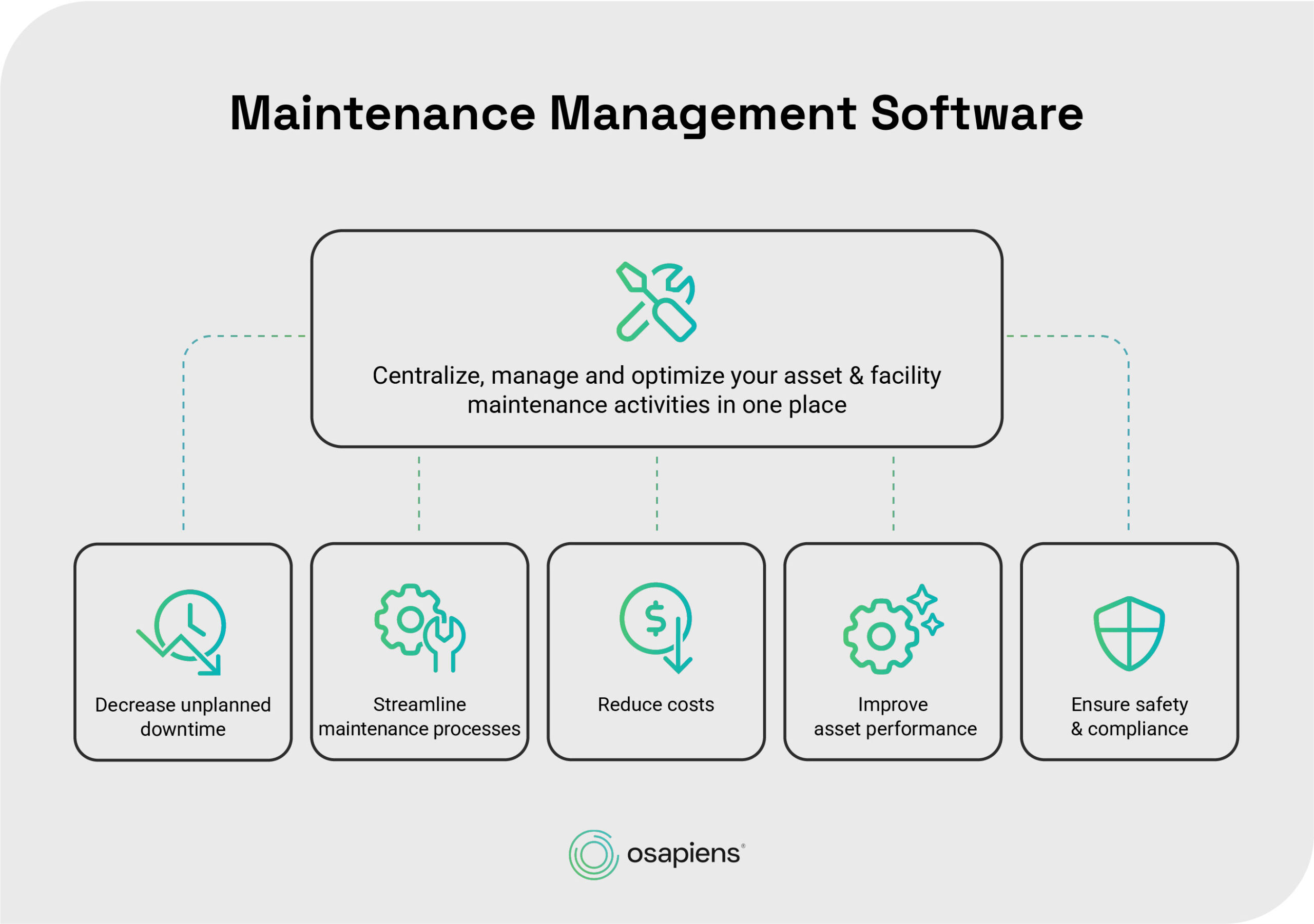
The osapiens HUB for Maintenance delivers exactly what production facilities need: intuitive work order management, automated preventive maintenance workflows, and real-time visibility across all manufacturing facilities. Maintenance managers can see equipment status, track maintenance history, and optimize resource allocation – whether managing a single plant or multiple sites globally.
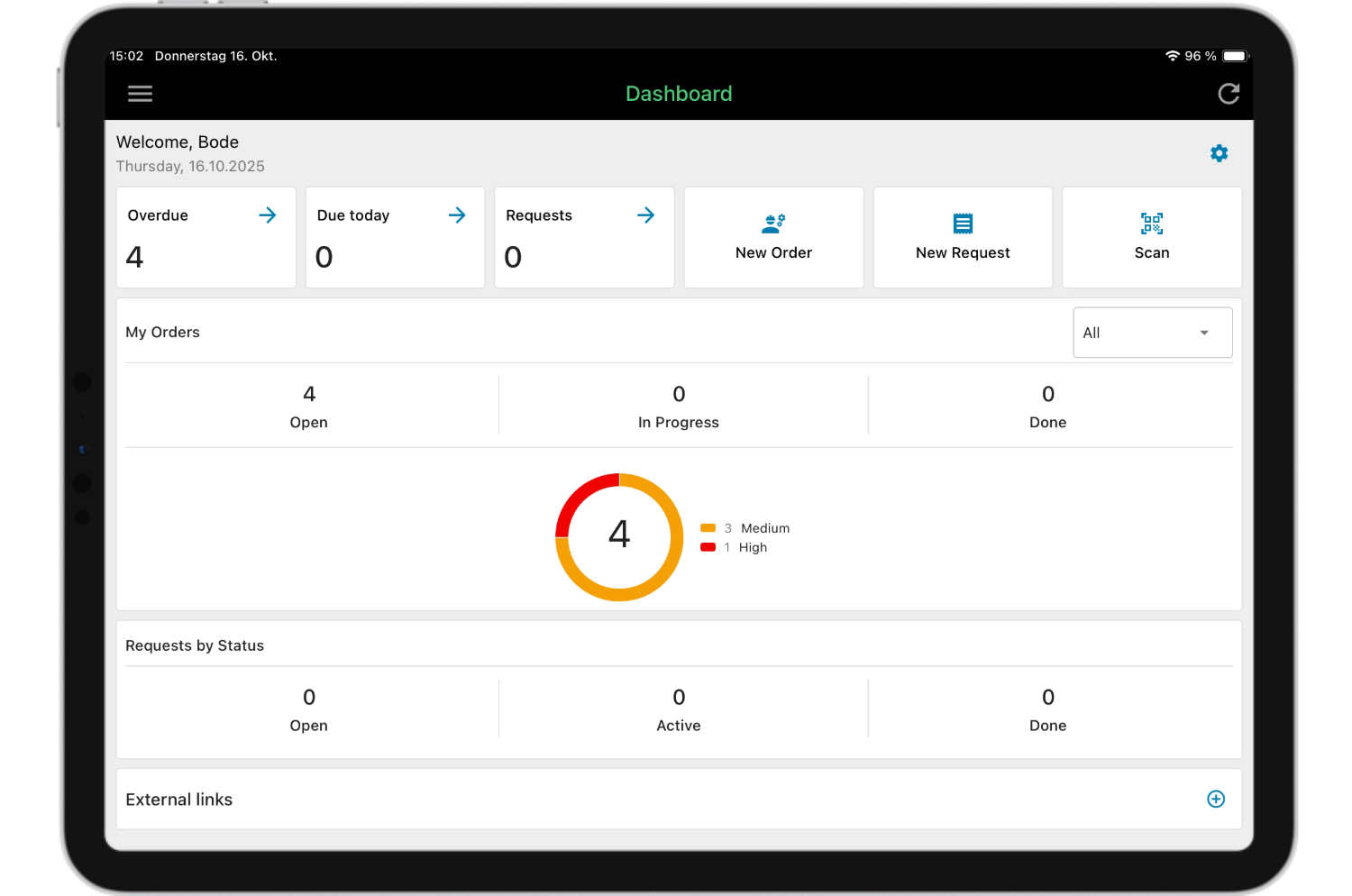
Why Manufacturing Companies Need Specialized Maintenance Software
Equipment downtime costs manufacturers an average of $260,000 per hour. Traditional reactive maintenance – fixing equipment only after it breaks – guarantees these expensive interruptions. Specialized maintenance software for manufacturing changes this approach by enabling proactive strategies that prevent failures before they occur.
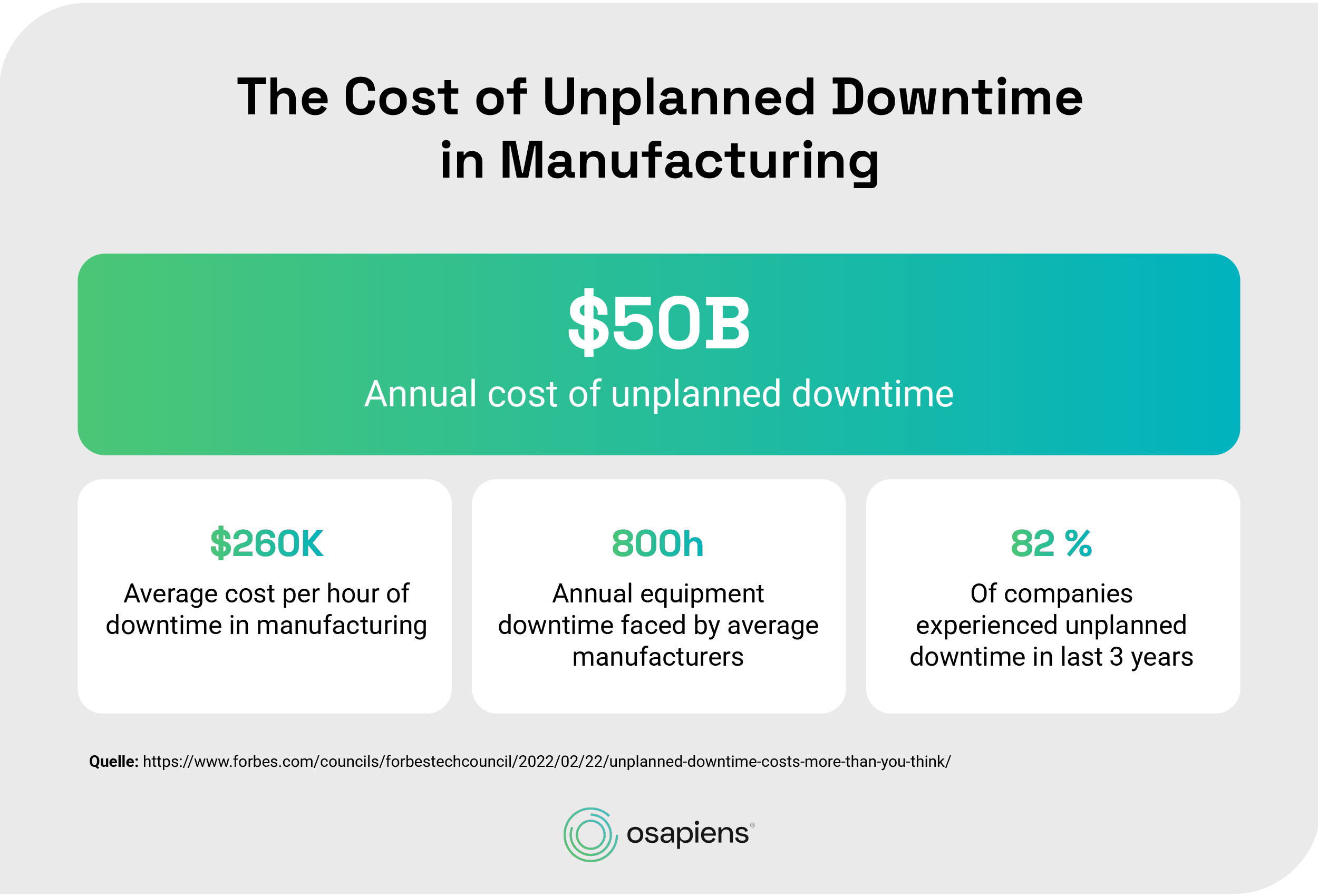
The osapiens HUB for Maintenance helps manufacturing companies manage complex production environments through automated preventive maintenance scheduling, real-time asset tracking, and mobile-first workflows. Whether you operate a single facility or manage multiple manufacturing plants globally, the platform delivers the visibility and control needed to maximize equipment reliability. Calculate your potential ROI based on your facility’s current downtime patterns and see how preventive maintenance translates into measurable cost savings.
Reducing Unplanned Downtime
Automated preventive maintenance scheduling ensures critical assets receive regular attention based on manufacturer recommendations or operational hours. The osapiens HUB automatically generates work orders, assigns them to qualified technicians, and sends mobile notifications – reducing unplanned downtime by up to 32 %.
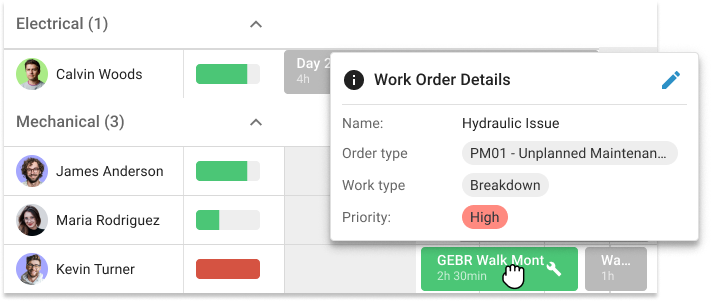
Improving Asset Reliability
Complete maintenance history, performance trends, and cost tracking enable data-driven decisions about repair versus replacement. The osapiens HUB’s asset management module provides real-time visibility into equipment health across all locations, helping maintenance managers optimize strategies and improve overall asset performance.
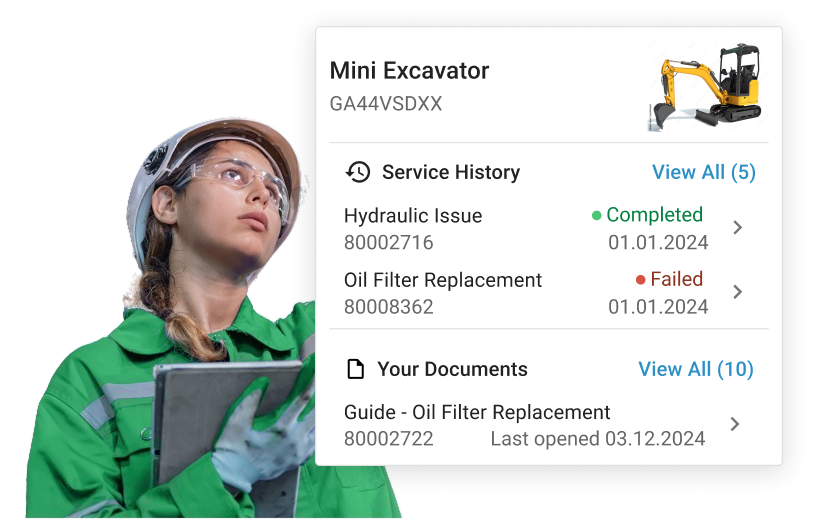
Ensuring Compliance and Safety in Manufacturing Maintenance
Manufacturing facilities must navigate complex regulatory landscapes that demand meticulous documentation and audit-ready records. Manufacturing maintenance software transforms compliance from a manual burden into an automated, systematic process.
Key compliance and safety capabilities:
- Complete audit trails: The osapiens HUB automatically documents every maintenance activity – who performed the work, when it happened, which procedures were followed, and what spare parts were used.
- Regulatory standards: Support for FDA 21 CFR Part 11 (pharmaceutical), GMP requirements, ISO standards, and industry-specific protocols ensures your maintenance operations meet all applicable regulations.
- Enforceable safety procedures: Digital checklists guide maintenance technicians through proper lockout/tagout protocols, PPE requirements, and safety inspections – preventing shortcuts and ensuring consistent compliance.
- Calibration management: Automated scheduling and tracking for precision equipment calibration maintains quality standards and regulatory requirements.
- Skills-based assignments: The system ensures only qualified, certified personnel receive assignments requiring specific expertise, reducing safety incidents while maintaining compliance.
Essential Features of Maintenance Software for Manufacturing
Not all CMMS platforms deliver what manufacturing environments actually need. Production facilities require specific functionality that goes beyond basic work order tracking – from deep ERP integration to offline mobile capabilities that work in areas without network coverage.
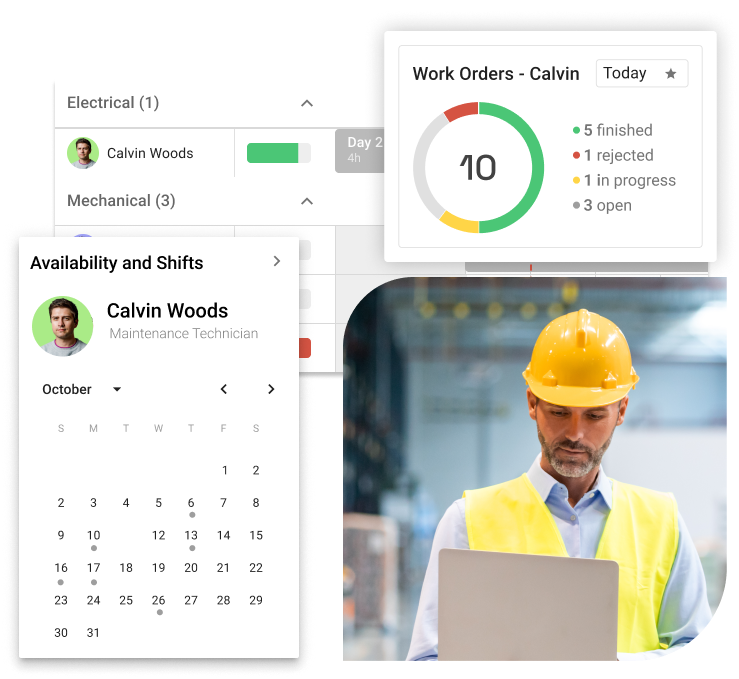
Integration Capabilities
Manufacturing operations depend on seamless data flow between maintenance and enterprise systems. Manual data entry between your CMMS and SAP creates errors, delays, and duplicate work. The osapiens HUB eliminates these issues with its SAP-certified connector for bidirectional integration.
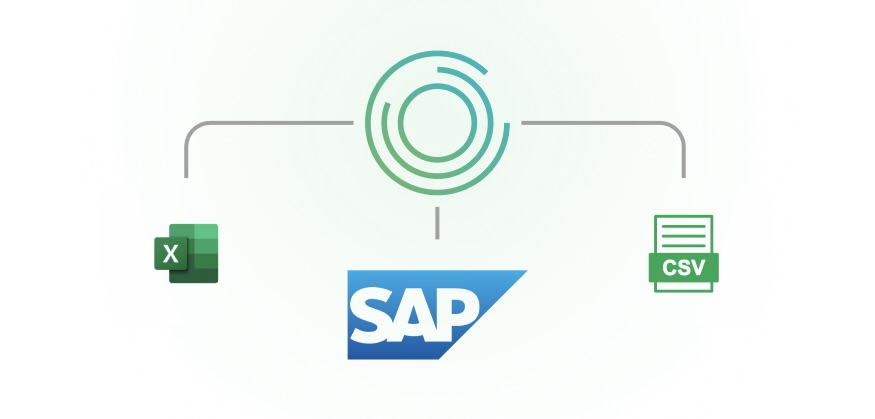
This certification matters. While many vendors claim SAP compatibility, only SAP-certified solutions guarantee reliable integration that survives system updates. The osapiens connector synchronizes equipment master data, work orders, costs, and inventory management automatically – ensuring maintenance data remains accurate across your entire enterprise.
Mobile Access and Offline Functionality
Maintenance technicians work where the equipment is – often in production areas with limited or no connectivity. Generic cloud-based tools fail when internet access drops. The osapiens HUB delivers a full-featured mobile CMMS app with complete offline functionality.
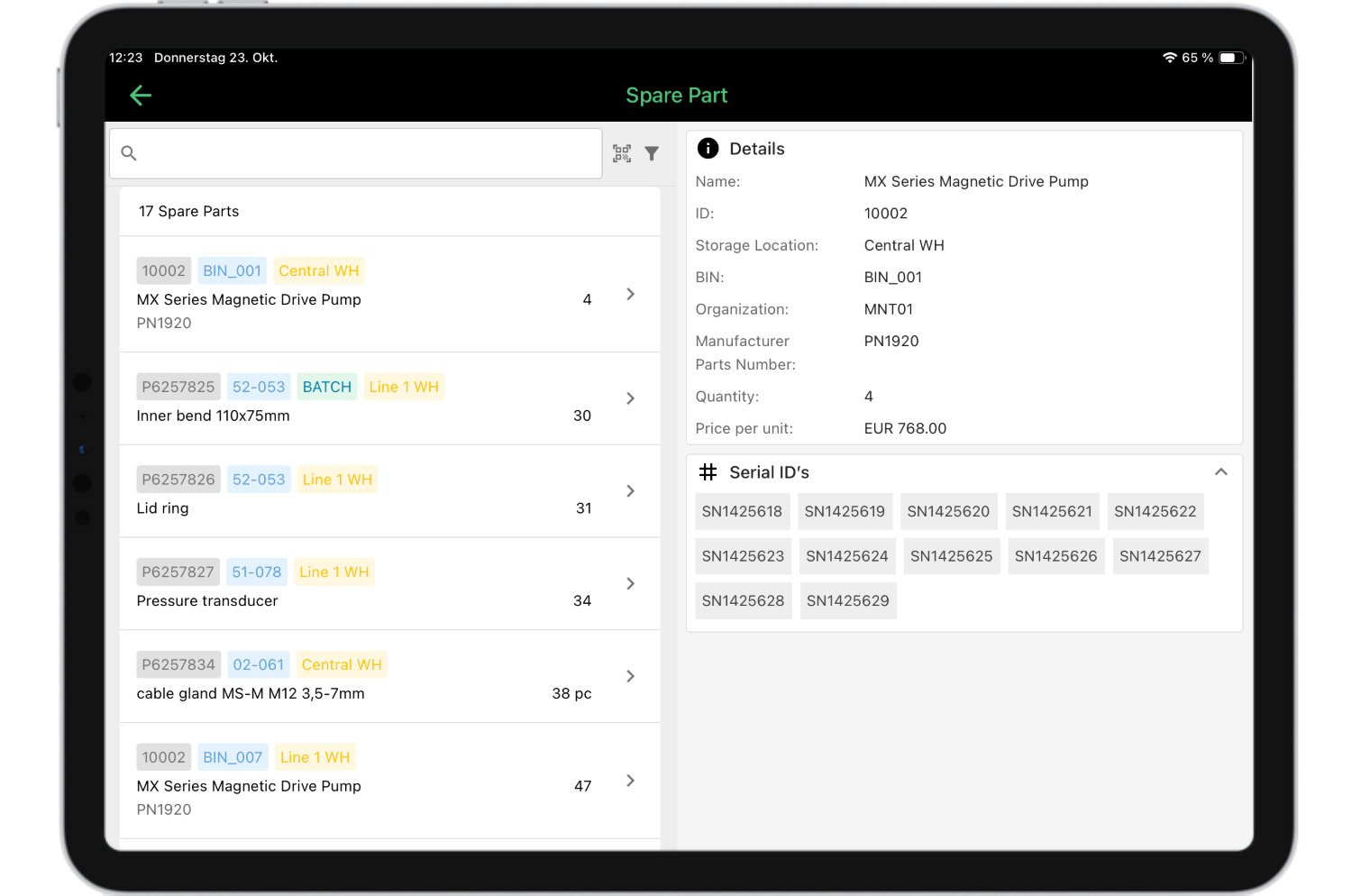
Technicians can access equipment history, complete work orders, fill out digital checklists, capture photos, and log spare parts usage – all without internet connection. Once connectivity returns, the app automatically synchronizes all data. This capability ensures maintenance work never stops due to network issues.
Preventive Maintenance Scheduling
Automated preventive maintenance scheduling forms the foundation of proactive maintenance strategies. The osapiens HUB enables you to create preventive maintenance tasks based on calendar intervals, operational hours, production cycles, or custom triggers specific to your manufacturing environment.

The system automatically generates work orders, assigns them based on technician skills and availability, and sends mobile notifications. Digital checklists ensure consistent execution of maintenance procedures, while the platform tracks completion rates and identifies which assets require attention.
Work Order Management
Efficient work order management requires more than creating tickets. The osapiens HUB provides automated task assignment based on skills, priority levels, and technician capacity. Maintenance managers gain real-time visibility into work progress, can track key performance metrics, and identify bottlenecks before they impact operations.
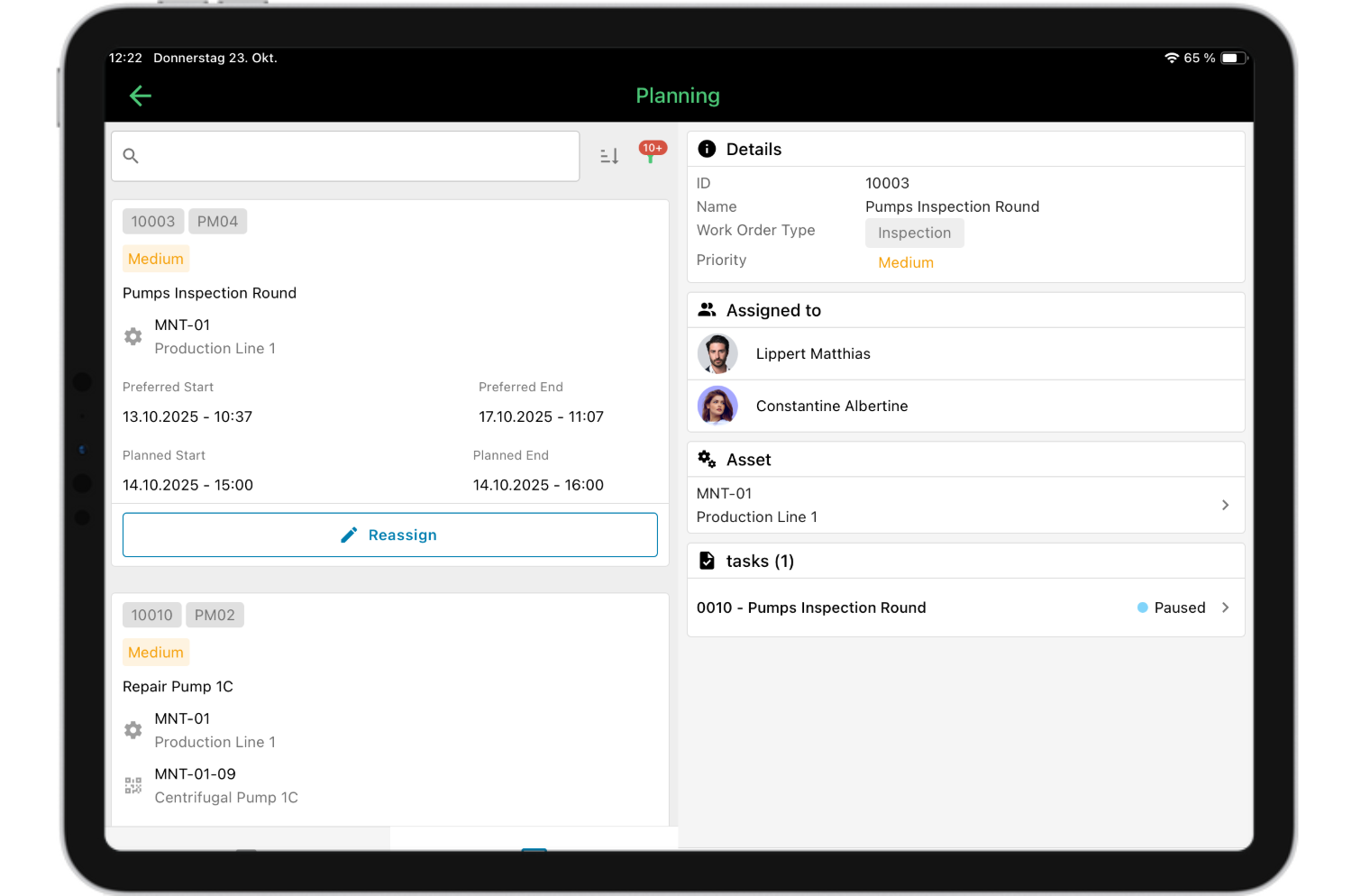
The platform’s offline capability is especially useful for work order execution. Technicians receive assignments on their mobile devices and can complete all tasks – including adding notes, attaching photos, and updating status – regardless of network availability.
Asset Management and Inventory Control
Comprehensive asset management tracking extends equipment lifespan and optimizes maintenance investments. The osapiens HUB maintains complete maintenance history for every asset, tracks performance metrics, and monitors maintenance costs. This visibility enables data-driven decisions about repair versus replacement.
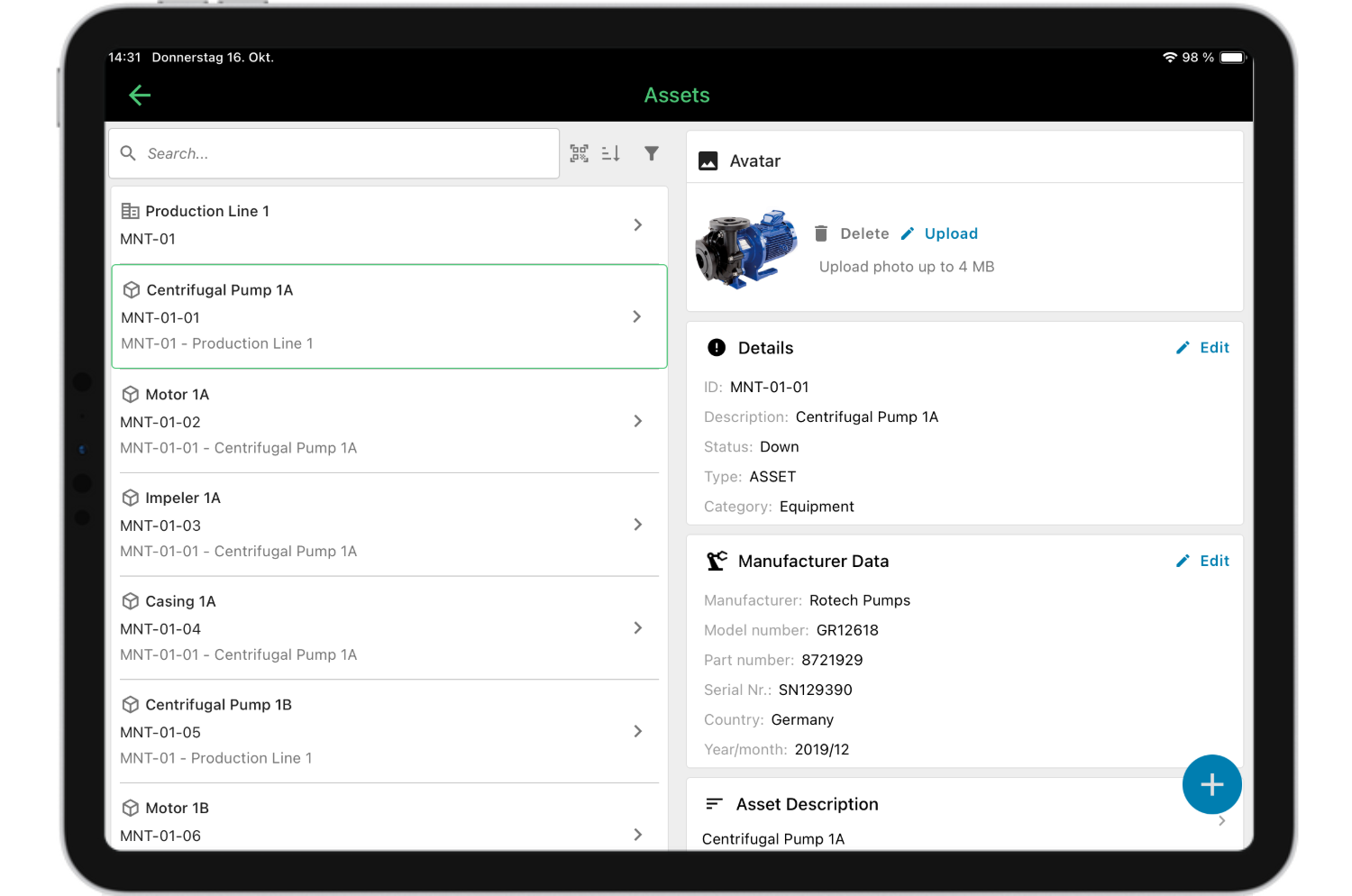
Integrated spare parts and inventory management ensures critical components remain available when needed. Track spare parts usage by work order and asset, manage multiple storage locations, set reorder points, and receive low-stock alerts. This robust inventory management prevents maintenance delays due to missing parts.
Preventive vs. Predictive Maintenance: Choosing the Right Strategy
Manufacturing companies face a strategic decision: invest in time-based preventive maintenance or adopt condition-based predictive maintenance? Both strategies reduce unplanned downtime, but they differ significantly in approach, cost, and complexity.
Comparison of maintenance strategies:
| Aspect | Preventive Maintenance | Predictive Maintenance |
|---|---|---|
| Approach | Scheduled maintenance at fixed intervals | Condition-based maintenance using sensor data |
| Technology Required | CMMS software, digital checklists | IoT sensors, analytics platforms, AI |
| Implementation Cost | Lower initial investment | Higher upfront costs for sensors and analytics |
| Best For | Standard equipment, proven failure patterns | Critical assets, high-value equipment |
| Downtime Reduction | up to 32 % reduction in unplanned failures | Up to 70 % reduction with accurate predictions |
| ROI Timeline | Immediate benefits within 3 – 6 months | Longer ROI period, 12 – 18 months typical |
Most manufacturing facilities benefit from a hybrid approach. Implement preventive maintenance as your foundation – it delivers immediate results with lower investment. Then selectively deploy predictive maintenance for critical assets where unexpected failures create the highest costs.
The osapiens HUB for Maintenance supports both strategies. Use automated preventive maintenance scheduling for standard equipment, while integrating sensor data and advanced analytics for predictive capabilities on your most valuable assets. This flexibility allows you to optimize your maintenance strategies based on equipment criticality and available resources.
Best Practices for Implementing Manufacturing Maintenance Software
Successful CMMS implementation requires more than selecting the right software. Manufacturing companies that achieve rapid ROI follow proven strategies that minimize disruption while maximizing user adoption.
Key implementation best practices:
- Start with clean asset data: Audit your asset inventory before importing equipment. Remove decommissioned items, standardize naming conventions, and ensure complete information – location, manufacturer, model number, and specifications.
- Prioritize high-impact assets first: Begin with critical equipment whose failure causes the greatest production impact. The osapiens HUB allows focused pilots that prove value quickly before expanding across all manufacturing facilities.
- Engage maintenance technicians early: Involve your maintenance teams during selection and implementation. The osapiens HUB’s intuitive mobile interface reduces training time, but hands-on involvement ensures the platform fits actual workflows.
- Leverage ERP integration: Take full advantage of the osapiens HUB’s SAP-certified connector to synchronize equipment master data, work orders, and costs automatically – eliminating duplicate data entry.
- Define realistic PM schedules: Establish preventive maintenance tasks based on manufacturer recommendations and equipment criticality. Start conservatively and refine based on results.
- Measure and optimize continuously: Track key metrics from day one – unplanned downtime, PM completion rates, mean time between failures, and maintenance costs. The osapiens HUB’s dashboards enable data-driven refinement.
Maximize Your Maintenance Efficiency with osapiens HUB
The osapiens HUB for Maintenance delivers everything production facilities need to eliminate reactive firefighting and maximize equipment reliability. Automated preventive maintenance workflows, mobile-first functionality with offline capabilities, and SAP-certified integration transform how manufacturing companies manage their assets.
Start with the free tier for up to 5 users and 10 work orders per month, then scale as your operations grow. Manufacturing facilities using the osapiens HUB report up to 32 % reduction in unplanned downtime, extended equipment lifespan, and maintenance teams focused on prevention rather than emergency repairs.
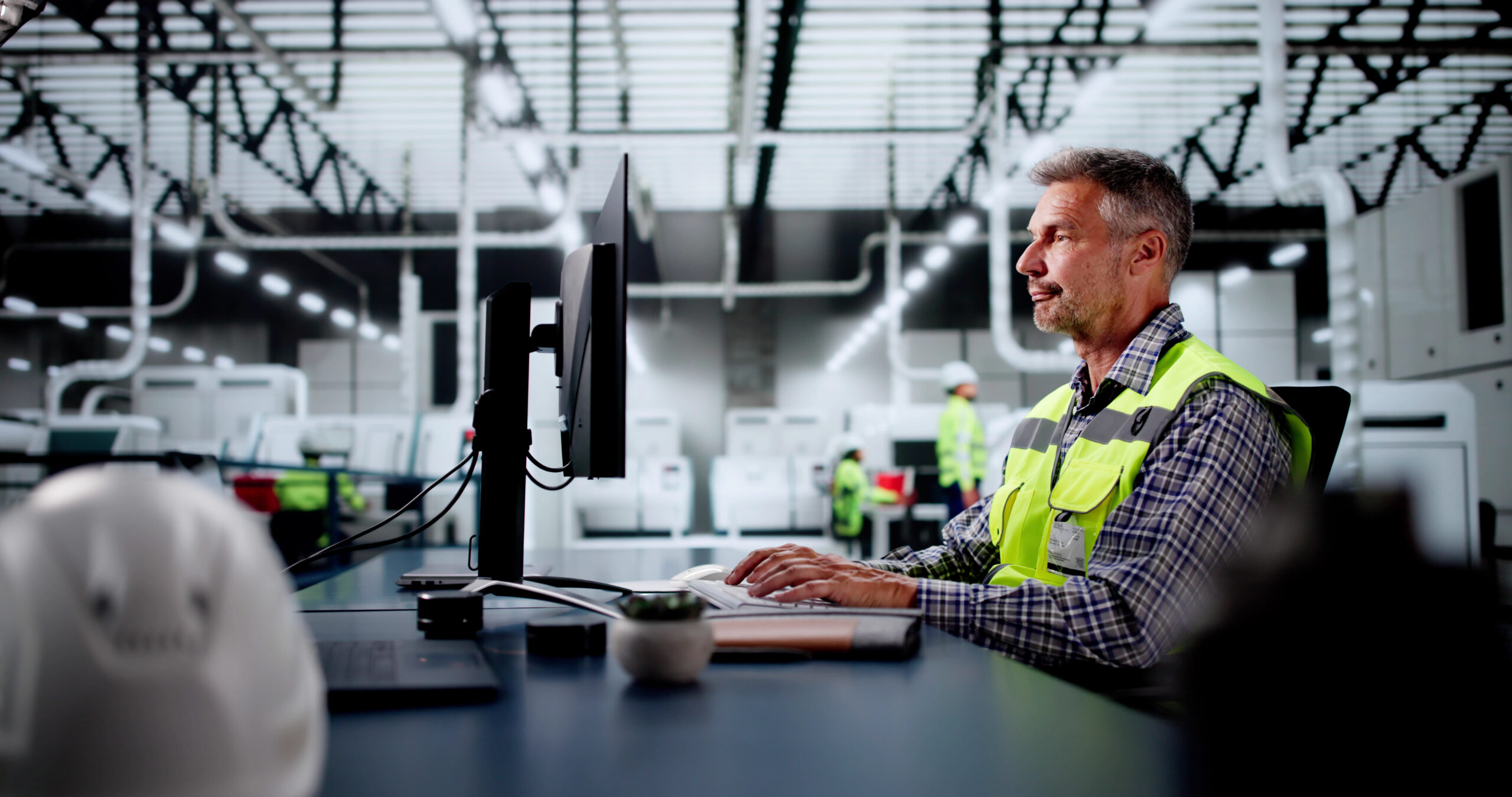
Complete maintenance history, real-time asset tracking, and integrated inventory management transform maintenance from a cost center into a strategic advantage. Make data-driven decisions, optimize technician productivity, and ensure compliance – all from a single platform. Calculate your ROI and see what your quantified benefits could be with osapiens.
FAQ
What is the best software for maintenance management?
The best maintenance management software depends on your specific requirements. For manufacturing facilities using SAP, the osapiens HUB for Maintenance stands out with its SAP-certified connector, mobile-first architecture with offline functionality, and automated preventive maintenance capabilities. As a comprehensive computerized maintenance management system, the platform scales from small operations with the free starter tier to enterprise deployments across multiple global sites.
What are the 4 types of software maintenance?
The four types of software maintenance are corrective (fixing bugs and errors), adaptive (updating software for new environments), perfective (improving performance and features), and preventive (proactive updates to avoid future issues). However, in manufacturing contexts, maintenance types refer to equipment strategies: reactive, preventive maintenance, predictive maintenance, and reliability-centered maintenance. These maintenance processes form the foundation of effective maintenance management process optimization.
Is SAP a CMMS or an ERP?
SAP is an ERP (Enterprise Resource Planning) system that includes a Plant Maintenance (PM) module. While SAP PM offers maintenance functionality, it lacks the user-friendly interface and mobile-first capabilities that modern maintenance technicians need. The osapiens HUB complements SAP by providing intuitive CMMS functionality with dedicated asset management software capabilities while maintaining seamless integration through its certified SAP connector – combining the best of both systems.
Which software is used for manufacturing?
Manufacturing facilities typically use multiple software systems: ERP platforms (like SAP) for enterprise planning, MES (Manufacturing Execution Systems) for production control, and CMMS software for asset management and maintenance operations. The osapiens HUB for Maintenance integrates with these systems to provide specialized maintenance functionality that reduces unplanned downtime, streamlines planned maintenance activities, and optimizes manufacturing operations.
